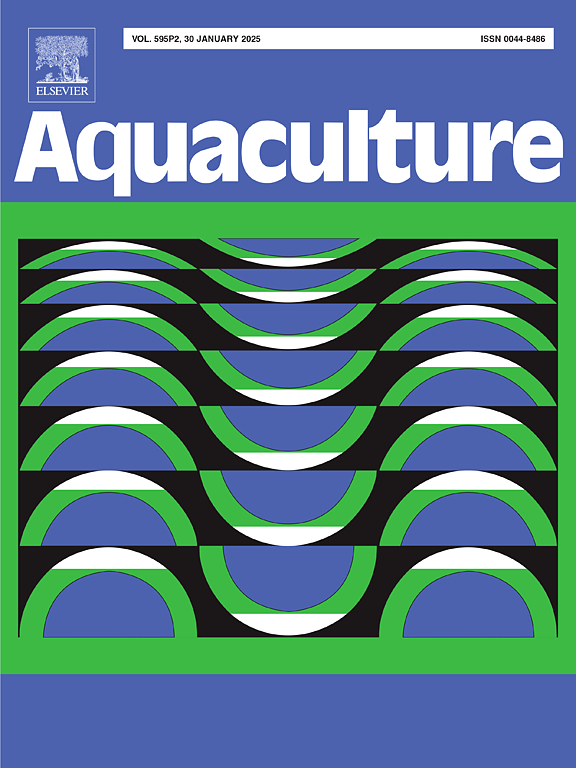Culture performance and physiology of triploid eastern oysters (Crassostrea virginica) in their northern range
IF 3.9
1区 农林科学
Q1 FISHERIES
引用次数: 0
Abstract
Triploid oysters have become a crucial tool for aquaculture because of their rapid growth rates and reduced reproduction compared to diploids. While extensively adopted in temperate regions along the U.S. East Coast, limited research has evaluated triploid oyster performance in the colder waters of the Northwest Atlantic where the growing season is shorter. This study investigated the growth performance, morphology, and physiology of cultured triploid and diploid Crassostrea virginica in their northern range. Environmental conditions as well as oyster shell and tissue growth were monitored over a 17-month period at two farm sites in Maine. Triploids averaged 22 % greater for shell height and 53 % greater for tissue mass compared to diploids. The effects of ploidy and environmental factors (temperature, chlorophyll-a, and particulate organic matter) on shell growth were examined using generalized additive models. Triploids exhibited a significant growth advantage in temperatures above 17 °C and at higher food concentrations with minimal advantage outside these conditions. In a laboratory experiment, tissue loss and oxygen consumption rates were examined over a ten-week period along with cell size measurements. Although triploids had larger cell sizes, standardized oxygen consumption rates during starvation did not differ significantly between ploidies, suggesting similar maintenance needs after contributions to feeding, growth, and reproduction are removed. Diploids, however, experienced faster tissue loss during starvation, indicating potential energetic disadvantages. These findings highlight the culture potential of triploid C. virginica in their northern range, provide insight into optimal environmental conditions for triploid advantage, and contribute to refining mechanistic triploid oyster growth models.
三倍体东方牡蛎(Crassostrea virginica)在其北部地区的培养性能和生理
与二倍体相比,三倍体牡蛎的生长速度快,繁殖率低,因此已成为水产养殖的重要工具。虽然三倍体牡蛎在美国东海岸的温带地区被广泛采用,但有限的研究已经评估了三倍体牡蛎在西北大西洋较冷的水域中的表现,那里的生长季节较短。本研究对三倍体和二倍体栽培的处女花的生长性能、形态和生理进行了研究。环境条件以及牡蛎壳和组织的生长在缅因州的两个农场进行了为期17个月的监测。三倍体的壳高比二倍体高22%,组织质量比二倍体高53%。采用广义加性模型研究了倍性和环境因子(温度、叶绿素a和颗粒有机质)对贝壳生长的影响。三倍体在温度高于17°C和食物浓度较高的条件下表现出显著的生长优势,在这些条件之外的优势很小。在一项实验室实验中,在十周的时间内,组织损失和氧气消耗率与细胞大小测量一起被检查。虽然三倍体的细胞大小较大,但饥饿期间的标准耗氧量在倍体之间没有显著差异,这表明在去除对喂养、生长和繁殖的贡献后,维持需求相似。然而,二倍体在饥饿期间经历了更快的组织损失,表明潜在的能量劣势。这些发现突出了三倍体牡蛎在其北部地区的培养潜力,为三倍体优势的最佳环境条件提供了新的认识,并有助于完善三倍体牡蛎的生长机制模型。
本文章由计算机程序翻译,如有差异,请以英文原文为准。
求助全文
约1分钟内获得全文
求助全文
来源期刊

Aquaculture
农林科学-海洋与淡水生物学
CiteScore
8.60
自引率
17.80%
发文量
1246
审稿时长
56 days
期刊介绍:
Aquaculture is an international journal for the exploration, improvement and management of all freshwater and marine food resources. It publishes novel and innovative research of world-wide interest on farming of aquatic organisms, which includes finfish, mollusks, crustaceans and aquatic plants for human consumption. Research on ornamentals is not a focus of the Journal. Aquaculture only publishes papers with a clear relevance to improving aquaculture practices or a potential application.
 求助内容:
求助内容: 应助结果提醒方式:
应助结果提醒方式:


